trailer OLDSMOBILE SILHOUETTE 1993 Owners Manual
[x] Cancel search | Manufacturer: OLDSMOBILE, Model Year: 1993, Model line: SILHOUETTE, Model: OLDSMOBILE SILHOUETTE 1993Pages: 323, PDF Size: 17.13 MB
Page 67 of 323
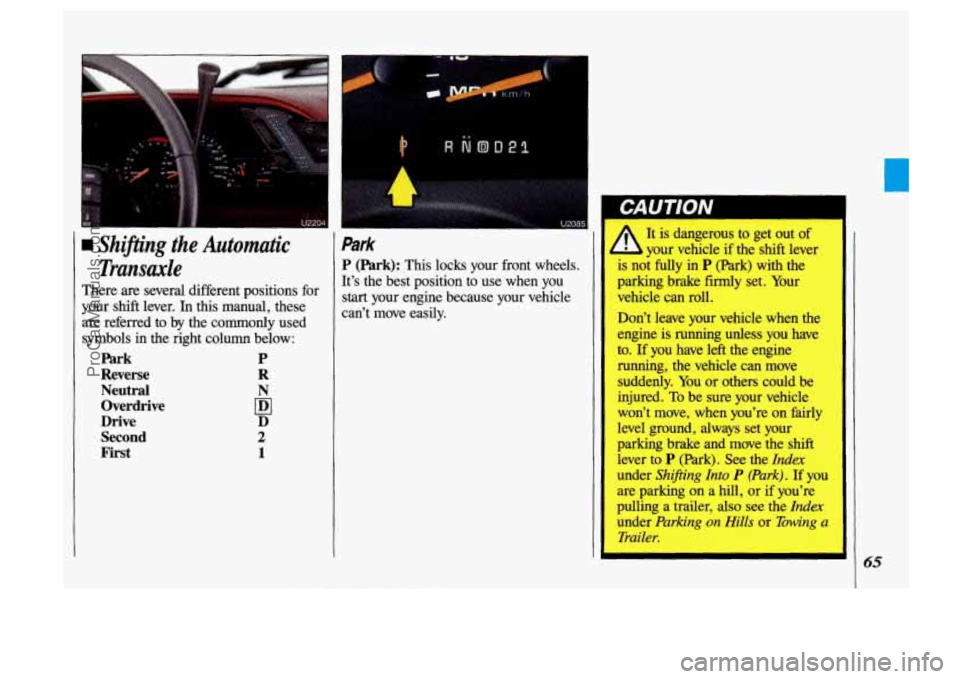
Sh#ting the Automatic
Tranm.de
There are several different positions for
your shift lever.
In this manual, these
are referred
to by the commonly used
symbols
in the right column below:
Park P
Reverse R
Neutral
Overdrive
&
Drive D
Second 2
First 1
Park
P (Park): This locks your front wheels.
It's the best position to use when you
start your engine because your vehicle
can't move easily. It
is dangerous to get out of
A your vehicle if the-shift lever
1s not fully in P (Park) with the
parking brake firmly set. Your
vehicle can roll.
Don't leave your vehicle when the
engine is running unless you have
to.
If you have left the engine
running, the vehicle can move suddenly. You or others could be
injured.
To be sure your vehicle
won't move, when you're on fairly
level ground, always set your
parking brake and move the shift lever to
P (Park). See the Index
under Shifting Into P (Park). If you
are parking
on a hill, or if you're
pulling a trailer, also see the
Index
under Parking on Hills or Towing a
Trailer.
ProCarManuals.com
Page 69 of 323
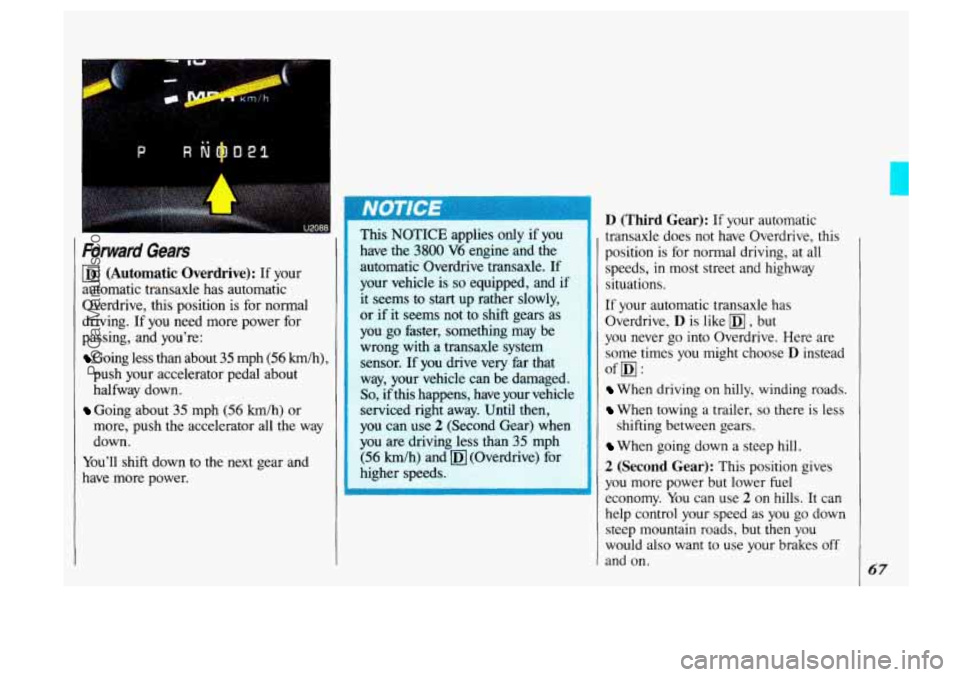
Fonvard Gears
(DI (Automatic Overdrive): If your
automatic transaxle has automatic
Overdrive, this position is for normal
driving.
If you need more power for
passing, and you’re:
Going less than about 35 mph (56 km/h),
push your accelerator pedal about
halfway down.
Going about 35 mph (56 km/h) or
more, push the accelerator all the way
down.
You’ll shift down to the next gear and
have more power. have
the
3.800 V6-engine and the
automatic Overdrive transaxle. If
your vehicle
is so equipped, and if
it seems to
start up rather slowly,
or if it seems not to shift gears as
you go faster, something may be
wrong with a transaxle system
sensor. If you drive very far that
way, your vehicle can be damaged.
So, if this happens, have your vehicle
serviced right away. Until then,
you can use
2 (Second Gear) when
you are driving less than
35 mph
(56 km/h) and (Overdrive) for
higher speeds? . --~ :~~~ - ~ , ~~. =-== ~~ ~=~ ~ .=- .~ ~..~ ..~... .~.= ~~ . .. .. .. ..
D (Third Gear): If your automatic
transaxle does not have Overdrive, this
position is for normal driving, at all
speeds, in most street and highway
situations.
If your automatic transaxle has
Overdrive,
D is like , but
you never go into Overdrive. Here are
some times you might choose
D instead
When driving on hilly, winding roads.
When towing a trailer, so there is less
When going down a steep hill.
2 (Second Gear): This position gives
you more power but lower fuel
economy. You can use
2 on hills. It can
help control your speed as you go down
steep mountain roads, but
then you
would also want to use your brakes off
and on.
ofH:
shifting between gears.
67
ProCarManuals.com
Page 71 of 323

To Release the Parking Brake:
Hold the regular brake pedal down. Pull
the BRAKE RELEASE lever.
Driving with the parking brake
on
can cause your rear brakes to
overheat. You may have to replace
them, and you could also damage
i other parts of your vehicle. .. , m
If You are on a Hill:
See the Index under Parking on Hills.
That section shows how to turn your
front wheels.
If You are Towing a Trailer and are
Parking on Any Hill:
See the Index under Towing a Trailer.
That section shows what to do first to
keep the trailer
from moving.
Shiithg Into P (Park)
1
A
It is dangerous to get out 01
your vehicle if the shift lever
is not fully in
P (Park) with the
parking brake
firmly set. Your
vehicle can roll. If you have left
engine running, the vehicle can
move suddenly. You or others
could be injured.
To be sure your
vehicle won't move, when you're
on fairly level ground, use the
steps that follow.
If you are parking
on a hill,
or if you're pulling a
trailer, also see the Index under
Parking on Hills or Towing a
Trailer.
I
1. Hold the brake pedal down with your
right
foot and set the parhng brake.
69
ProCarManuals.com
Page 74 of 323

Features & Controls
n
Running bur Engine While You’re Parked
It’s better not to park with the engine running. But if you ever have to, here are
some things to know.
LAU I IUlV
A
Idling the engine with the air system control off could allow dangerous
exhaust into your vehicle (see the earlier CAUTION under
Engine
Exhaust).
Also, idling in a closed-in place can let deadly carbon monoxide (CO) into
your vehicle even if the fan switch
is at the highest setting. One place this can
happen is a garage. Exhaust-with CO-can come in easily.
Never park in a
garage with the engine running.
Another closed-in place can be a blizzard. (See the
Index under Blizzard.)
It can be dangerous to get out of your vehicle if the shift lever is not fully in
P (Park) with the parking brake firmly set. Your vehicle can roll. Don’t leave
your vehicle when the engine is running unless you have to.
If you’ve left the
engine running, the vehicle can move suddenly. You or others could be
injured.
To be sure your vehicle won’t move, even when you’re on fairly level
ground, always set your parking brake and move the shift lever to
P (Park).
Follow the proper steps to be sure your vehicle won’t move. See the
Index
under Shifing Into P (Park).
If you are parking on a hill, or if you’re pulling a trailer, also see the Index
under Parking on Hills or Towing a Trailer.
Horn
You can sound the horn by pressing the
horn symbols on your steering wheel.
ProCarManuals.com
Page 77 of 323
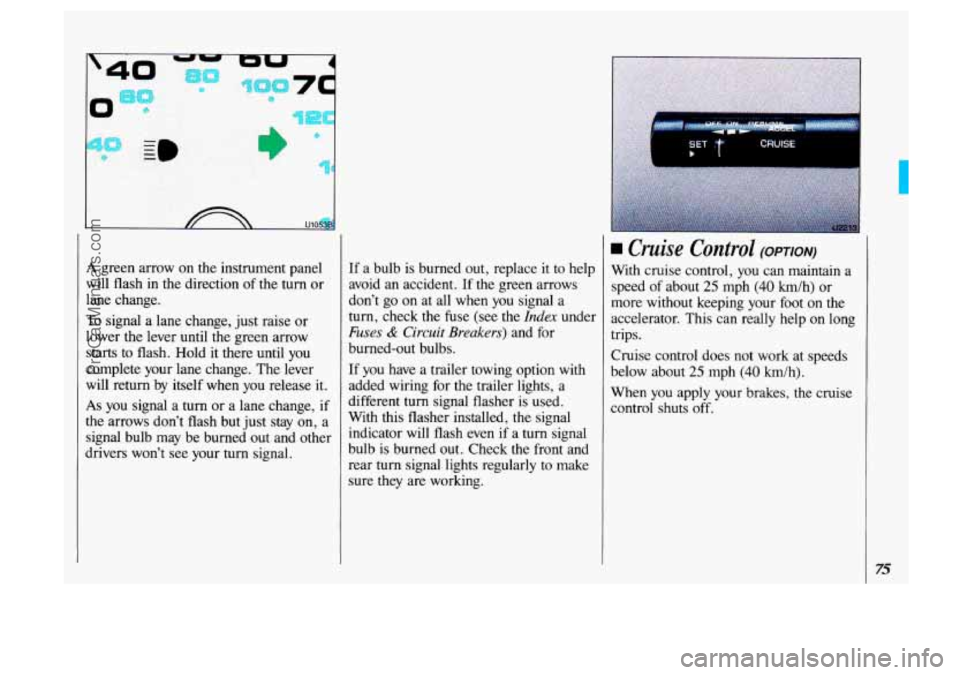
I
I&
A green arrow on. the instrument panel
will flash in the direction of the turn or
lane change.
To signal a lane change, just raise or
lower
the lever until the green arrow
starts to flash. Hold it there until you
complete your lane change. The lever
will return by itself when
you release it.
As you signal a turn or a lane change, if
the arrows don’t flash but just stay on, a
signal bulb may be burned out and other
dhvers won’t see your turn signal. If
a bulb is burned out, replace
it to help
avoid an accident. If the green arrows
don’t go on at all when you signal a
turn, check the fuse (see the
Index under
Fuses & Circuit Breakers) and for
burned-out bulbs.
If you have a trailer- towing option with
added wiring for the trailer lights, a
different
turn signal flasher is used.
With this flasher installed, the signal
indicator will flash even if a turn signal
bulb is burned out. Check
the front and
rear turn signal lights regularly to make
sure they are working.
SET T CRUISE b I
Cruise Control (OPTION)
With cruise control, you can maintain a
speed
of about 25 mph (40 km/h) or
more without keeping your foot
on the
accelerator. This can really help
on long
trips.
Cruise control does not work at speeds
below about
25 mph (40 km/h).
When you apply your brakes, the cruise
control shuts off.
75
ProCarManuals.com
Page 141 of 323

Here you’ll find information about
driving on different kinds of roads
and in varying weather conditions
.
We’ve also included many other useful
tips on driving
.
Part
Your Driving and the Road
Roadsigns ...................................................... 140
Defensive Driving
................................................ 144
Drunken Driving
................................................. 145
Control
of a Vehicle ............................................... 147
Braking
....................................................... 148
Anti-LockBrakes
............................................... 149
SteeringTips
................................................... 154
Passing
....................................................... 156
DrivingatNight
.................................................. 159
Driving in the Rain
................................................ 161
Driving in Fog. Mist and Haze
...................................... 164
CityDriving
..................................................... 165
Freeway Driving
................................................. 166
Driving
a Long Distance ........................................... 168
HillandMountainRoads
........................................... 170
ParkingonHills
.................................................. 171
Winter Driving
................................................... 173
TowingaTrailer
.................................................. 177
Steering in Emergencies
.......................................... 155
139
ProCarManuals.com
Page 179 of 323
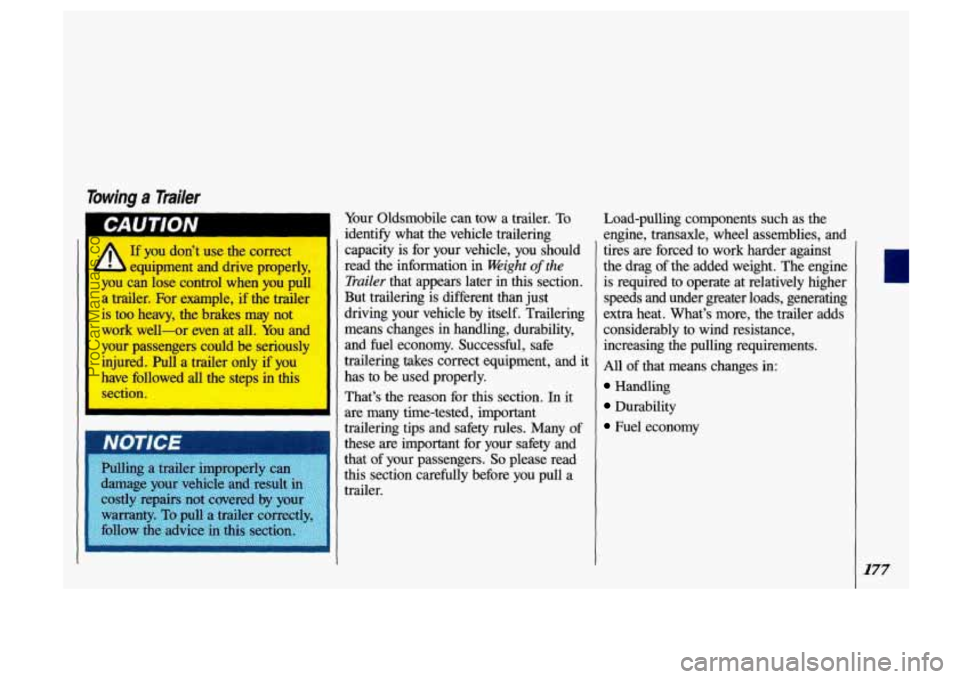
Towing a Tmiler
I I If you don’t use the correct I
L L equipment and drive properly,
you can lose control when you pull
a trailer. For example, if the trailer
is too heavy, the brakes may not
work well-or even at all. You and
your passengers could be seriously
injured. Pull a trailer only
if you
have followed all the steps in this section. Your
Oldsmobile can tow a trailer. To
identify what the vehicle trailering
capacity is for your vehicle, you should
read the information in
Weight of the
Trailer
that appears later in this section.
But trailering
is different than just
driving your vehicle
by itself. Trailering
means changes
in handling, durability,
and fuel economy. Successful, safe
trailering takes correct equipment, and
it
has to be used properly.
That’s the reason for
this section, In it
are many time-tested, important
trailering tips and safety rules. Many of
these are important for your safety and
that of your passengers.
So please read
this section carefully before you pull a
trailer. Load-pulling components such as the
engine, transaxle, wheel assemblies, and
tires
are forced to work harder against
the drag of the added weight. The engine
is required to operate at relatively higher
speeds and under greater loads, generating
extra heat. What’s more, the trailer adds
considerably to wind resistance, increasing the pulling requirements.
All
of that means changes in:
Handling
Durability
Fuel economy
177
ProCarManuals.com
Page 180 of 323
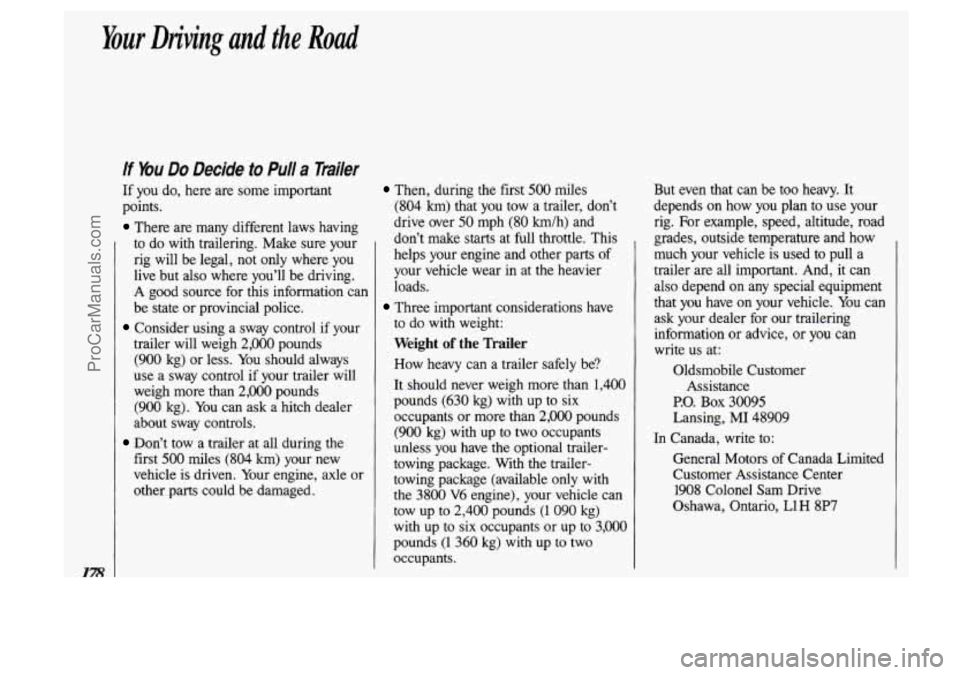
Your Driving and the Road
If You Do Decide to Pull a Trailer
If you do, here are some important
points.
There are many different laws having
to do with trailering. Make sure your
rig will be legal, not only where you
live but also where you’ll be driving.
A good source for this information can
be state or provincial police.
Consider using a sway control if your
trailer will weigh 2,000 pounds
(900 kg) or less. You should always
use a sway control if your trailer will
weigh more than 2,000 pounds
(900 kg). You can ask a hitch dealer
about sway controls.
Don’t tow a trailer at all during the
first
500 miles (804 km) your new
vehicle is driven. Your engine, axle or
other parts could be damaged.
Then, during the first 500 miles
(804
km) that you tow a trailer, don’t
drive over
50 mph (80 km/h) and
don’t make starts at full throttle. This
helps your engine and other parts of
your vehicle wear in at the heavier
loads.
Three important considerations have
to do with weight:
Weight of the Trailer
How heavy can a trailer safely be?
It should never weigh more than 1,400
pounds (630 kg) with up to six occupants or more than 2,000 pounds
(900 kg) with up to two occupants
unless you have the optional trailer-
towing package. With the trailer-
towing package (available only with
the 3800
V6 engine), your vehicle can
tow up to 2,400 pounds (1 090 kg)
with up
to six occupants or up to 3,000
pounds (1 360 kg) with up to two
occupants. But even
that can be too heavy. It
depends on how you plan to use your
rig. For example, speed, altitude, road
grades, outside temperature and how
much your vehicle is used to pull a
trailer are all important. And, it can
also depend on any special equipment
that you have on your vehicle. You can
ask your dealer for
our trailering
information or advice, or you can
write us at:
Oldsmobile Customer Assistance
P.O. Box 30095
Lansing,
MI 48909
General Motors of Canada
L
Customer Assistance Center
1908 Colonel Sam Drive
Oshawa, Ontario, L1H 8P7
In
Canada, write to:
Jmited
ProCarManuals.com
Page 181 of 323

Weight of the Trailer Tongue
The tongue load (A) of any trailer is
an important weight to measure
because it affects the total, gross
weight of your vehicle. The gross
vehicle weight
(GVW) includes the
curb weight of the vehicle, any cargo
you may carry in it, and the people
who will be riding in the vehicle. And
if you will tow a trailer,
you must add
the tongue load
to the GVW because
your vehicle will be carrying that
weight, too.
See the Index under
Loading Your khicle for more
information about your vehicle’s
maximum load capacity.
If your vehicle is not equipped to tow
a trailer weighing more than
2,000
pounds (900 kg) with the 3.1L V6 or
3800 V6 engine, the trailer tongue (A)
should weigh 10% of the total loaded
trailer weight
(B).
If your vehicle is equipped to tow up
to
3,000 pounds (1 360 kg) with the
3800
V6 engine towing package, and
if you’re using a “dead-weight” hitch,
the trailer tongue
(A) should weigh
10% of the total loaded trailer weight
(B). Or, if you have a “weight-
distributing” hitch, the trailer tongue
(A) should weigh 12% of the total
loaded trailer weight
(B).
After you’ve loaded your trailer, weigh
the trailer and then the tongue, separately,
to see if the weights are proper. If they
aren’t, you may be able to get them right
simply by moving some items around in
the trailer.
Total Weight on Your Vehicle’s Tires I
Be sure your vehicle’s tires are inflated
to the limit for cold tires.
You will find
these numbers on the Certification/
Tire label at the rear edge
of the
driver’s door (or see the
Index under
Tire Loading). Then be sure you don’t
go over the GVW limit for your
vehicle.
ProCarManuals.com
Page 182 of 323

Your Driving and the Road
180
If You Do Decide to Pull a Trailer
(CON X)
Hitches
It’s important to have the correct hitch
equipment. Crosswinds, large trucks
going by, and rough roads are a few
reasons why you’ll need the right hitch.
Here are some rules to follow:
If you’ll be pulling a trailer that, when
loaded, will weigh more than 2,000
pounds (900 kg), be sure to use a
properly mounted, weight-distributing hitch and sway control of the proper
size. This equipment is very important
for proper vehicle loading and good
handling when you’re driving.
Will you have to make any holes in the
body of your vehicle when you install
a trailer hitch?
If you do, then be sure
to seal the holes later when you remove
the hitch. If
you don’t seal them, deadly
carbon monoxide (CO) from your
exhaust can get into your vehicle. (See
Index under Carbon Monoxide in
Exhaust.) Dirt and water can, too.
The bumpers on your vehicle are not
intended for hitches. Do not attach
rental hitches or other bumper-type
hitches to them. Use only a frame-
mounted hitch that does not attach to
the bumper.
Safety Chains
You should always attach chains
between your vehicle and your trailer. Cross the safety chains under the tongue
of the trailer
so that the tongue will not
drop to the road if it becomes separated
from
the hitch. Instructions about safety
chains may be provided by the hitch
manufacturer or by the trailer
manufacturer. Follow the manufacturer’s
recommendation for attaching safety
chains. Always leave just enough slack
so you can turn with your rig. And, never
allow safety chains to drag on the
ground.
Trailer Brakes
If your trailer weighs more than 1,OOO
pounds (450 kg) loaded, then it needs its
own brakes-and they must be adequate.
Be sure to read and follow the
instructions for the trailer brakes
so
you’ll be able to install, adjust and
maintain them properly.
Because you have anti-lock brakes, do
not try to
tap into your vehicle’s brake
system. If
you do, both brake systems
won’t work well, or at all.
ProCarManuals.com